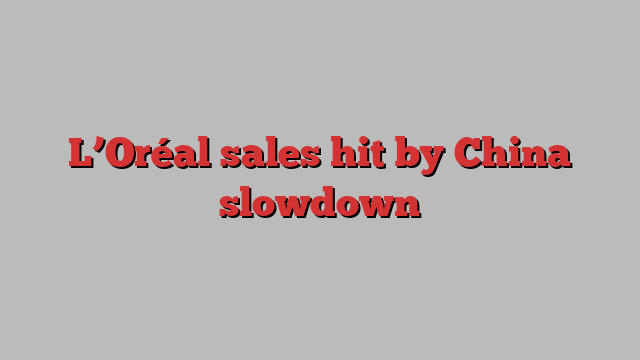
Unlock the Editor’s Digest for free
Roula Khalaf, Editor of the FT, selects her favourite stories in this weekly newsletter.
Sales of lipstick and skincare products in China fell in the second quarter at beauty group L’Oréal, weighing on the beauty group’s growth as conditions in the country remain “challenging”, the French company said.
L’Oréal, which owns brands ranging from high street favourite Maybelline to high-end skincare label Helena Rubinstein, said overall sales grew 5.3 per cent on a like-for-like basis in the second quarter to €10.88bn — coming in just above analyst expectations, according to Reuters, but slowing from 11 per cent growth in the first three months of the year.
Revenues in north Asia dropped 2.4 per cent on a comparable basis as sales in China, which had already been under pressure in the first quarter, fell further.
“Operating conditions in the Chinese ecosystem remained challenging,” said L’Oréal, adding that low consumer confidence was compounding a tough comparison base even as travel retail in offshore destinations such as Hainan had improved sequentially during the first half of the year.
However, first-half operating profit rose 8 per cent to €4.6bn compared with the same period a year ago, slightly above consensus estimates compiled by Reuters.
L’Oréal, the world’s biggest beauty company by sales, has had several years of record sales and profits as pandemic shopping and the so-called “lipstick effect” — where consumers are willing to spend on modest luxuries even when household budgets are squeezed — boosted performance despite inflation. However, the Paris-based beauty group now faces a more uncertain environment.
Chief executive Nicolas Hieronimus had already dialled back expectations for global beauty market growth at the end of June because of continuing weakness in China, saying at an event that he expected growth of between 4.5 to 5 per cent for the year as opposed to above 5 per cent forecasted previously. Shares in L’Oréal and other beauty companies fell in reaction.
“Our continued strong momentum in emerging markets, Europe and North America allowed us to more than offset the depressed beauty market in mainland China and the unfavourable comparative in travel retail,” Hieronimus said on Tuesday, adding that he expected the group would continue to outperform the beauty market despite “an environment that continues to be marked by economic and geopolitical tensions”.
The group’s consumer products division, its biggest by sales and home to Maybelline and the L’Oréal brand, rose 6.7 per cent — a slowdown from earlier in the year as the US mainstream beauty market shows signs of softness.
The weakness in China weighed on the company’s luxury division, although it still managed to grow 2.8 per cent on a like-for-like basis in the second quarter, an acceleration from the first quarter, boosted by double-digit growth in North America and emerging markets.
“L’Oréal has so far successfully managed a sluggish China beauty market by delivering above-trend growth elsewhere. However, we recognise that a prolonged period of market weakness in China remains the main risk,” said Rogerio Fujimori, an analyst at Stifel.
Shares in the beauty group have fallen more than 12 per cent so far this year to trade at €389, giving it a market capitalisation of €208bn.